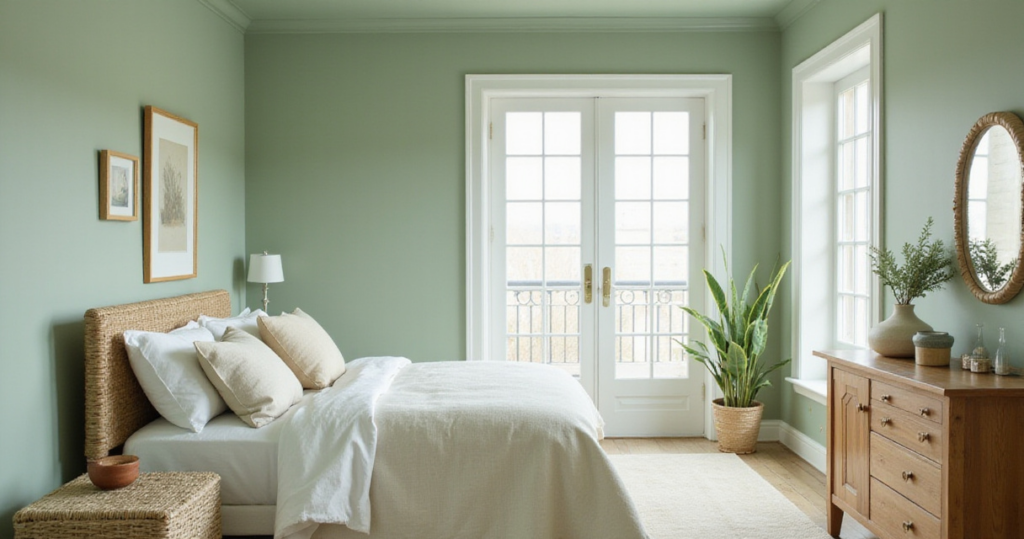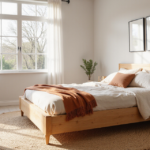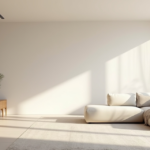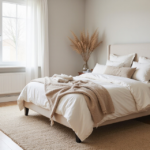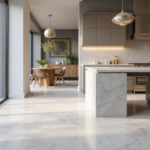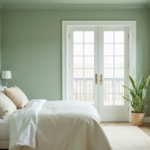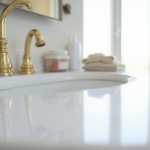Creating a bedroom that nurtures both your well-being and the planet shouldn’t feel like an impossible dream. Your personal sanctuary can become a powerful statement of environmental consciousness while delivering the restorative sleep and tranquil atmosphere you crave. The intersection of sustainability and style has never been more accessible, offering countless opportunities to craft a space that reflects your values without sacrificing beauty or comfort.
Modern bedrooms often harbor hidden environmental hazards—from off-gassing furniture to synthetic textiles that disrupt air quality. But what if your most intimate space could actively contribute to your health while reducing your ecological footprint? These 23 green bedroom ideas prove that conscious design choices create profound impacts, transforming ordinary rooms into extraordinary sanctuaries that celebrate both personal wellness and planetary stewardship.
1. Paint Walls in Serene Sage Green for Natural Calm
Sage green walls create an immediate connection to nature’s most restorative palette, leveraging color psychology to reduce stress and promote deeper sleep. This muted, earthy hue naturally lowers heart rate and cortisol levels, making it ideal for bedrooms where tranquility is paramount. When you choose low-VOC or zero-VOC paint formulations, you’re eliminating harmful off-gassing that can trigger respiratory issues and headaches for years after application.
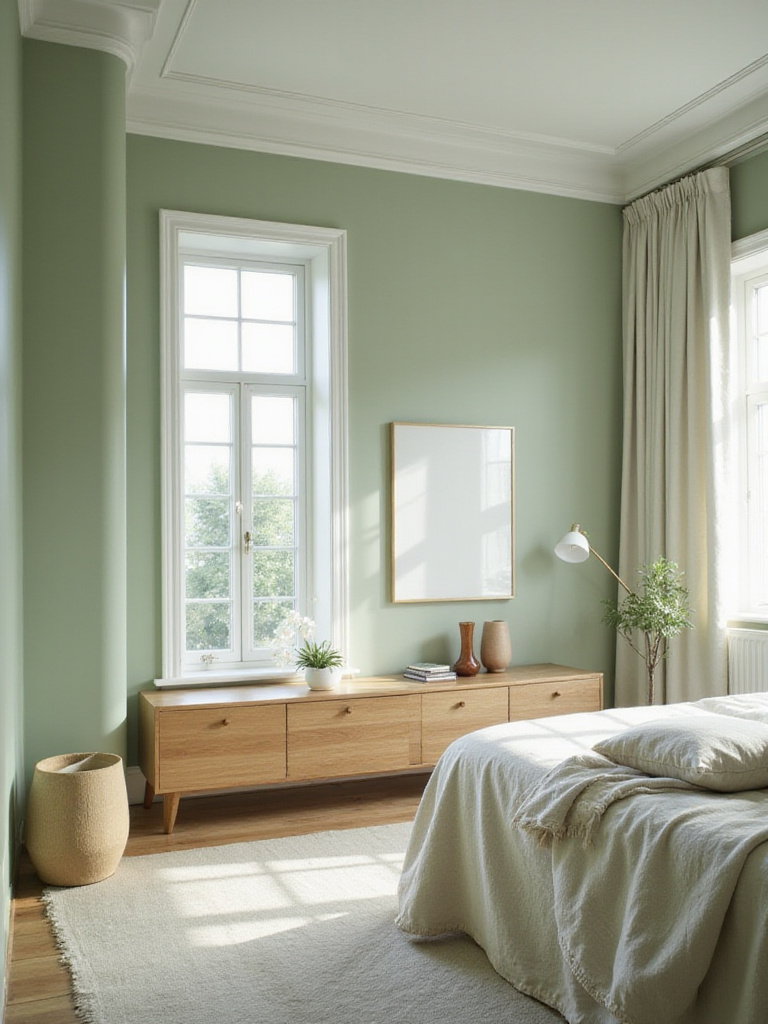
The psychological benefits of sage green extend far beyond aesthetics. Research published in the Journal of Environmental Psychology demonstrates that exposure to green environments reduces physiological stress indicators by up to 15%. This color choice becomes even more powerful when you consider that the EPA identifies indoor air as potentially 100 times more polluted than outdoor air, with conventional paints being major contributors to this problem.
- Health Benefits: Reduces stress hormones, improves sleep onset time, eliminates VOC exposure
- Environmental Impact: Zero harmful emissions, supports sustainable paint manufacturing
- Design Advantage: Creates visual spaciousness, complements natural materials beautifully
The magic of this piece lies in its ability to transform your bedroom’s entire energy while supporting your respiratory health. Choose brands like Benjamin Moore’s Natura or Sherwin-Williams’ Harmony for guaranteed low-VOC formulations that deliver both beauty and peace of mind.
2. Create a Deep Forest Green Accent Wall for Grounding
While sage offers gentle tranquility, a deep forest green accent wall introduces dramatic sophistication that makes your bedroom feel like a luxurious retreat. This rich, saturated hue creates visual depth while maintaining the psychological benefits of green’s natural calming properties. The key lies in selecting the wall behind your headboard, where this bold choice becomes a powerful focal point that enhances rather than overwhelms your space.
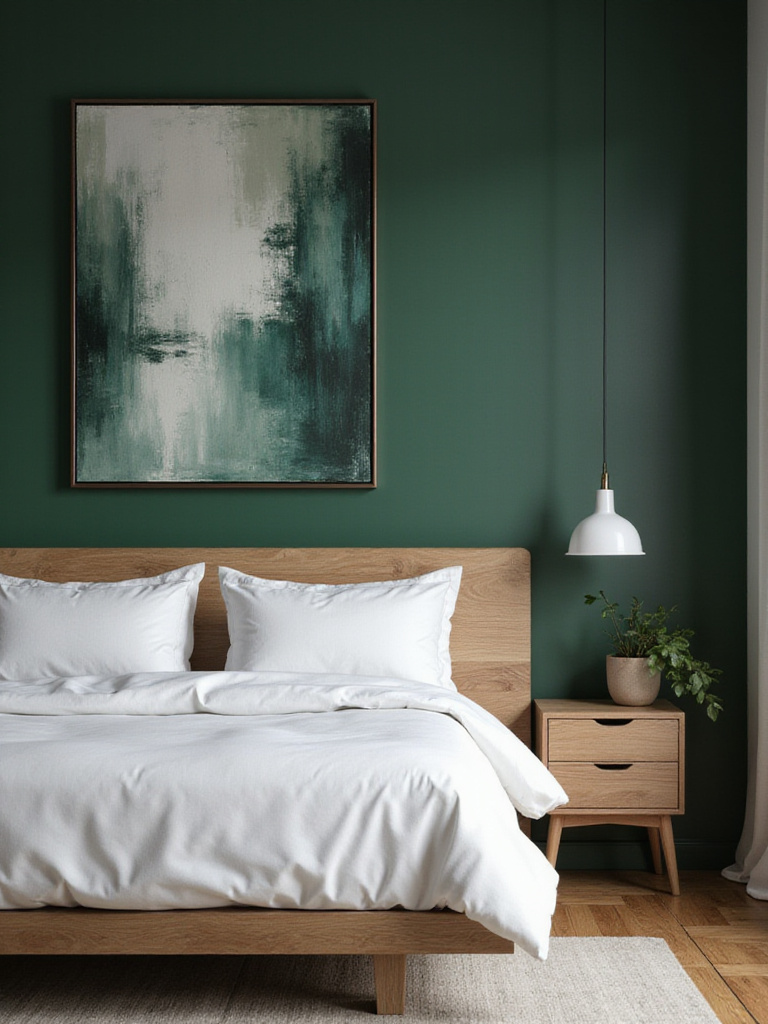
Deep forest green possesses unique properties that make smaller bedrooms appear larger by creating the illusion of depth and distance. Interior designers consistently recommend this approach for its ability to make lighter elements—white bedding, natural wood furniture, or metallic accents—appear more vibrant and luminous. The contrast creates visual interest while maintaining the serene atmosphere essential for quality sleep.
Beyond the obvious placement behind your headboard, consider using this technique to define a reading nook or meditation corner within your bedroom. The psychological impact of deep green promotes feelings of security and stability, crucial elements for creating a truly restorative environment.
3. Choose FSC-Certified Wood Furniture for Responsible Sourcing
FSC-certified wood furniture represents a fundamental shift toward responsible consumption, ensuring your bedroom pieces originate from forests managed with strict environmental and social standards. This certification combats illegal logging while supporting biodiversity conservation and fair labor practices throughout the supply chain. When you invest in FSC-certified pieces, you’re directly contributing to forest preservation efforts that protect endangered species and indigenous communities worldwide.
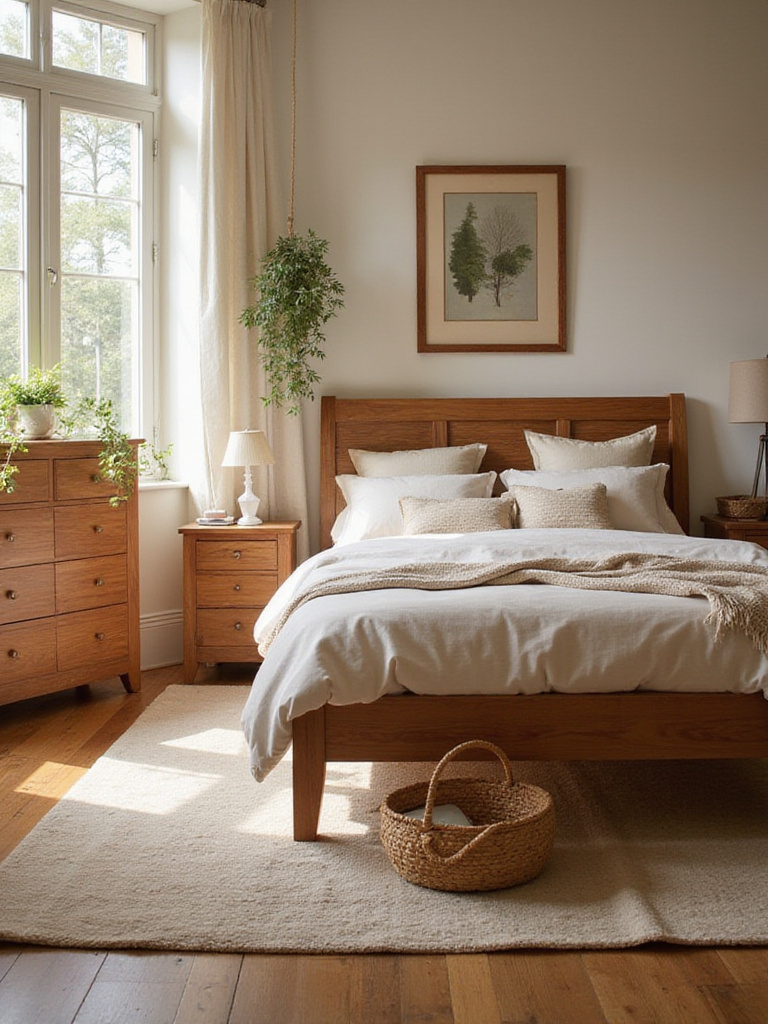
The environmental impact of choosing certified wood extends beyond forest conservation. FSC-certified areas experience 10-20% lower deforestation rates compared to non-certified forests, while maintaining higher biodiversity levels and supporting sustainable local economies. With over 220 million hectares of forest globally carrying FSC certification, your purchasing decisions contribute to a growing movement that prioritizes environmental stewardship over short-term profits.
- Verification Process: Look for the FSC logo and certification code on product labels
- Best Choices: Prioritize “FSC 100%” or “FSC Recycled” designations
- Quality Assurance: Seek furniture with low-VOC finishes and non-toxic adhesives
What makes this choice better for our planet is the comprehensive approach to sustainability that considers the entire product lifecycle, from forest management to manufacturing processes and end-of-life disposal.
4. Invest in Organic Cotton or Linen Bedding for Pure Comfort
Organic cotton and linen bedding transforms your sleep experience while eliminating exposure to the pesticides and synthetic chemicals commonly found in conventional textiles. These natural fibers offer superior breathability and temperature regulation, creating optimal conditions for restorative sleep. The cultivation process for organic cotton uses 91% less water than conventional methods, while linen requires minimal water and no pesticides, making both choices environmentally responsible.
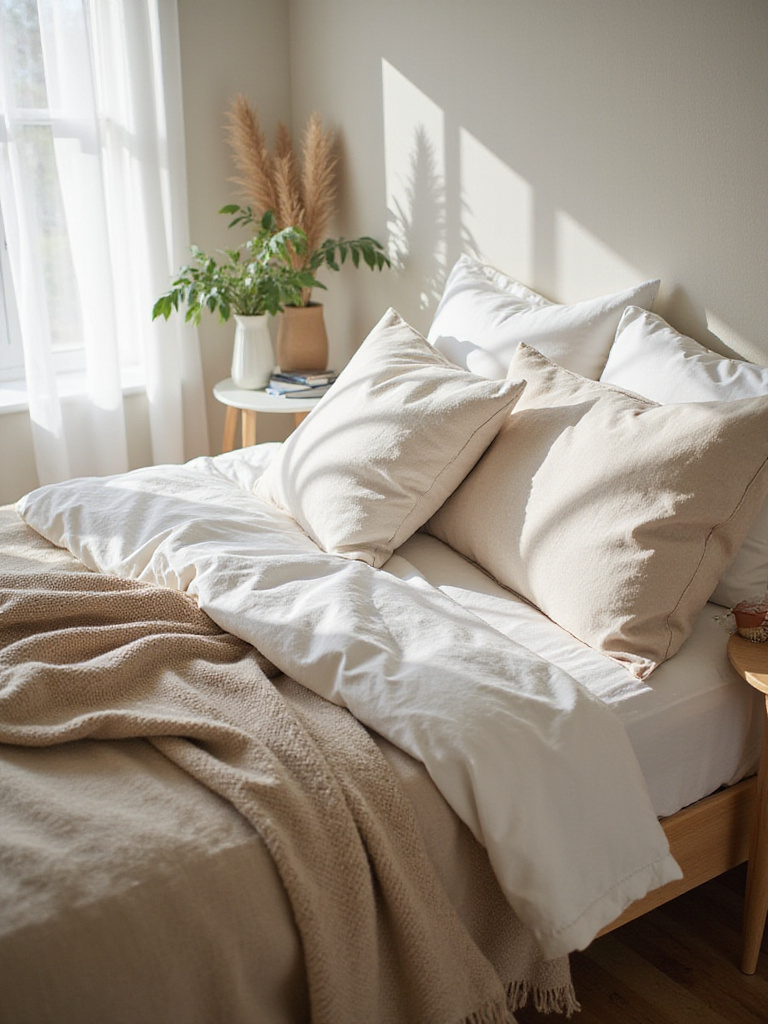
The health benefits of organic bedding become particularly evident for individuals with sensitive skin, allergies, or respiratory conditions. Conventional cotton production relies heavily on synthetic pesticides and fertilizers—accounting for 16% of global insecticide use—leaving residues that can irritate skin and airways. Organic alternatives provide a clean, chemical-free sleep environment that supports your body’s natural healing processes during rest.
Global Organic Textile Standard (GOTS) certification ensures your bedding meets rigorous ecological and social criteria throughout the supply chain. European Flax® certification for linen guarantees sustainable cultivation practices and superior fiber quality. These certifications provide transparency and accountability that conventional textile marketing cannot match.
The sustainable journey of these materials involves working with farmers who prioritize soil health, water conservation, and biodiversity protection, creating a positive environmental impact that extends far beyond your bedroom.
5. Integrate Air-Purifying Plants for Cleaner Indoor Air
Strategic placement of air-purifying plants creates a natural filtration system that removes volatile organic compounds while increasing oxygen levels in your bedroom. NASA’s Clean Air Study identified specific plants capable of removing up to 87% of common indoor toxins within 24 hours, establishing the scientific foundation for using plants as biological air filters. Snake plants, pothos, and peace lilies excel in bedroom environments, thriving in low light while working continuously to improve air quality.
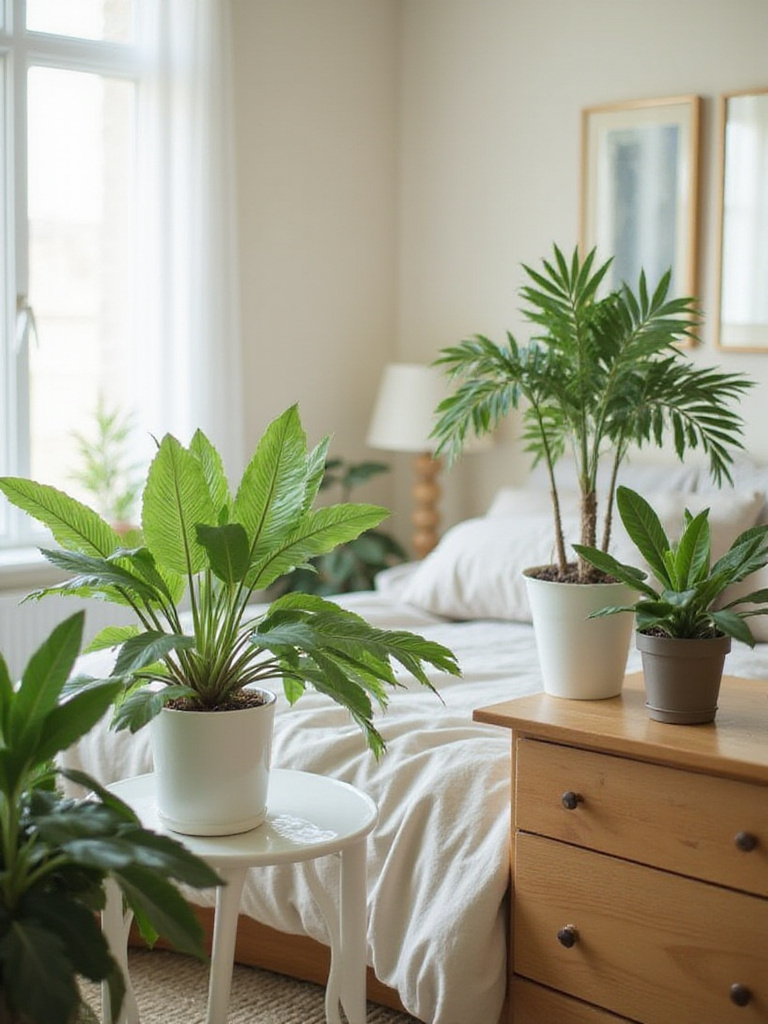
The health benefits extend beyond air purification to include increased humidity levels that alleviate dry skin and respiratory irritation. Plants also produce negative ions that can improve mood and cognitive function, creating a more restorative sleep environment. Research in the Journal of Physiological Anthropology shows that active interaction with indoor plants reduces diastolic blood pressure and subjective stress levels significantly.
- Top Bedroom Plants: Snake plants (release oxygen at night), ZZ plants (low light tolerance), spider plants (rapid air cleaning)
- Placement Strategy: 2-3 medium plants per 100 square feet for optimal air purification
- Care Requirements: Weekly watering, monthly leaf cleaning, adequate drainage
For those worried about maintenance, these plants forgive occasional neglect while continuing to provide air purification benefits that support better sleep and overall health.
6. Select Natural Fiber Rugs for Earthy Foundation
Jute and sisal rugs introduce organic textures that ground your bedroom design while offering significant environmental advantages over synthetic alternatives. These rapidly renewable plant fibers create visual warmth and tactile interest without the harmful VOC emissions associated with petroleum-based carpeting. The natural variation in color and texture adds depth to your space while supporting sustainable agricultural practices in developing countries.
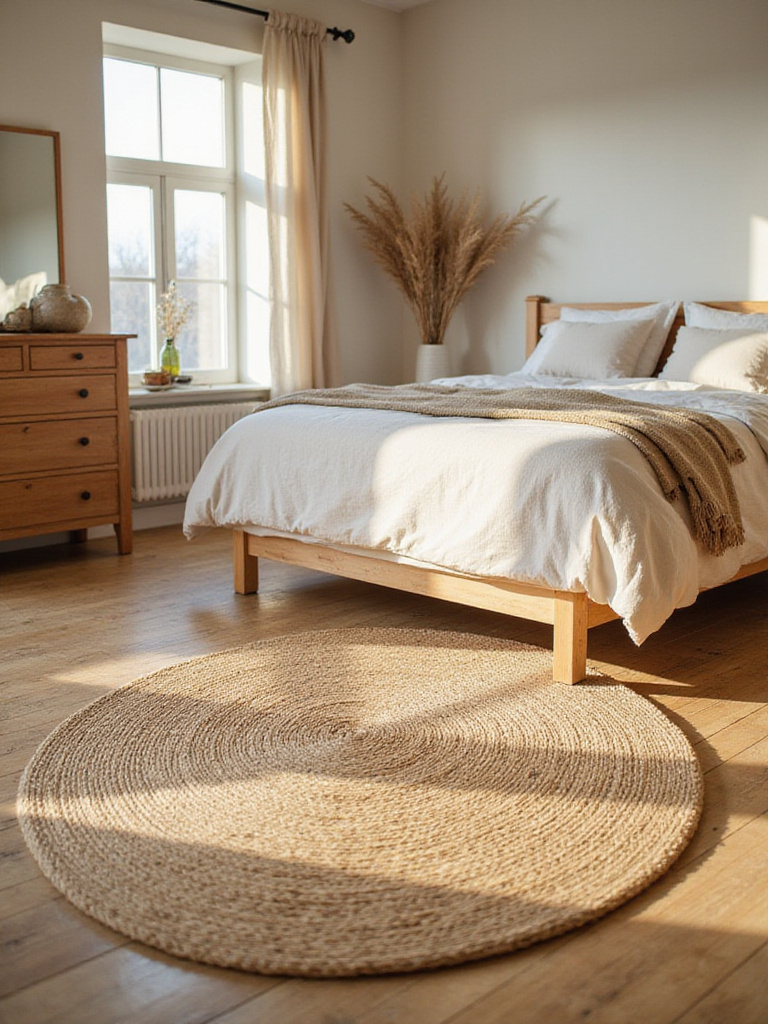
The environmental benefits of natural fiber rugs extend to their complete lifecycle. Unlike synthetic options that persist in landfills for centuries, jute and sisal rugs are 100% biodegradable and compostable at the end of their useful life. Their production requires minimal chemical processing and supports rural communities that depend on sustainable fiber cultivation for their livelihoods.
Sisal offers exceptional durability and resistance to wear, making it ideal for high-traffic areas, while jute provides softer underfoot comfort perfect for bedside placement. Both materials naturally resist static electricity and dust mites, contributing to a healthier bedroom environment for individuals with allergies or respiratory sensitivities.
The composition comes together when you layer different textures—perhaps a large sisal rug as your foundation with a smaller, softer accent rug beside the bed for enhanced comfort.
7. Install Thermal Blackout Curtains for Energy Conservation
Thermal blackout curtains serve dual purposes, creating optimal sleep conditions while significantly reducing your bedroom’s energy consumption throughout the year. These specialized window treatments can reduce heat loss by up to 25% in winter and decrease heat gain by 33% in summer, directly lowering utility bills while minimizing your carbon footprint. The Department of Energy identifies window treatments as one of the most cost-effective energy efficiency improvements available to homeowners.
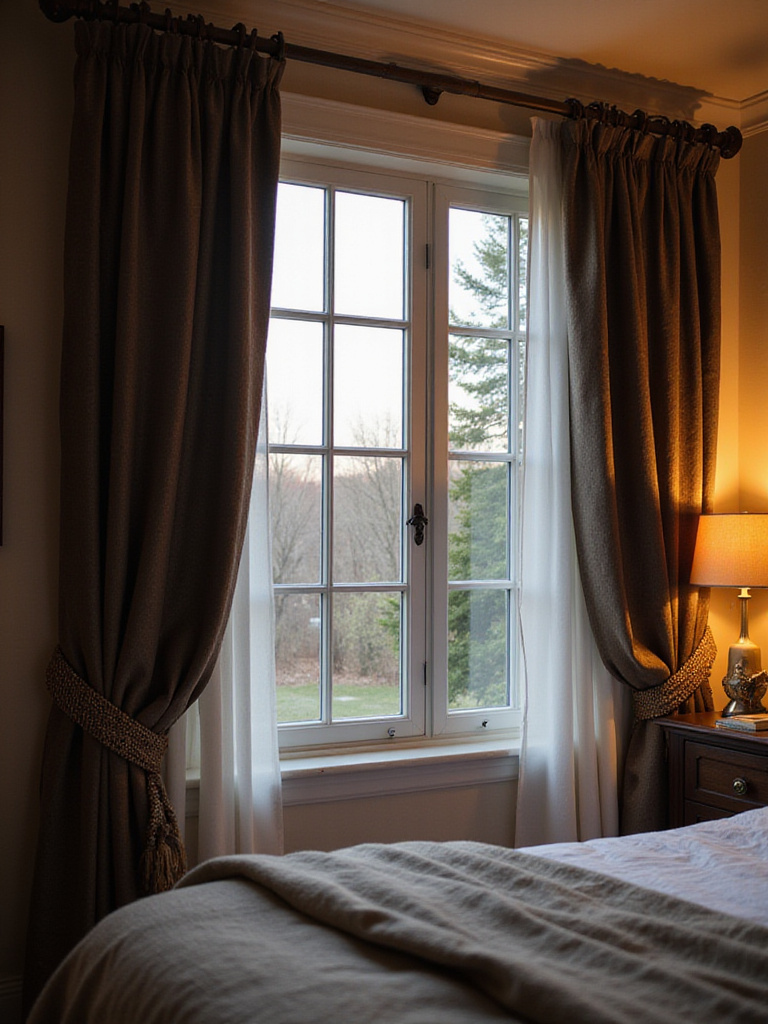
The sleep benefits of complete darkness cannot be overstated. Exposure to even minimal light during sleep suppresses melatonin production and disrupts circadian rhythms, leading to poor sleep quality and daytime fatigue. Thermal blackout curtains block 99% of external light while dampening outside noise, creating an ideal environment for deep, restorative sleep that supports immune function and mental clarity.
- Energy Savings: Up to 25% reduction in heating/cooling costs
- Sleep Quality: Complete darkness promotes natural melatonin production
- Noise Reduction: Multiple layers dampen external sounds significantly
The challenge of awkward spaces becomes easier when you select curtains that extend 6-12 inches beyond window frames and install them close to the wall to minimize air gaps and light leakage.
8. Upgrade to LED Lighting for Sustainable Illumination
LED lighting fixtures represent the most significant advancement in energy-efficient illumination, consuming up to 85% less electricity than traditional incandescent bulbs while lasting 25-50 times longer. This dramatic reduction in energy consumption directly translates to lower utility bills and reduced greenhouse gas emissions from power generation. ENERGY STAR estimates that widespread LED adoption could save $5 billion annually in energy costs while preventing 78 billion pounds of carbon emissions.
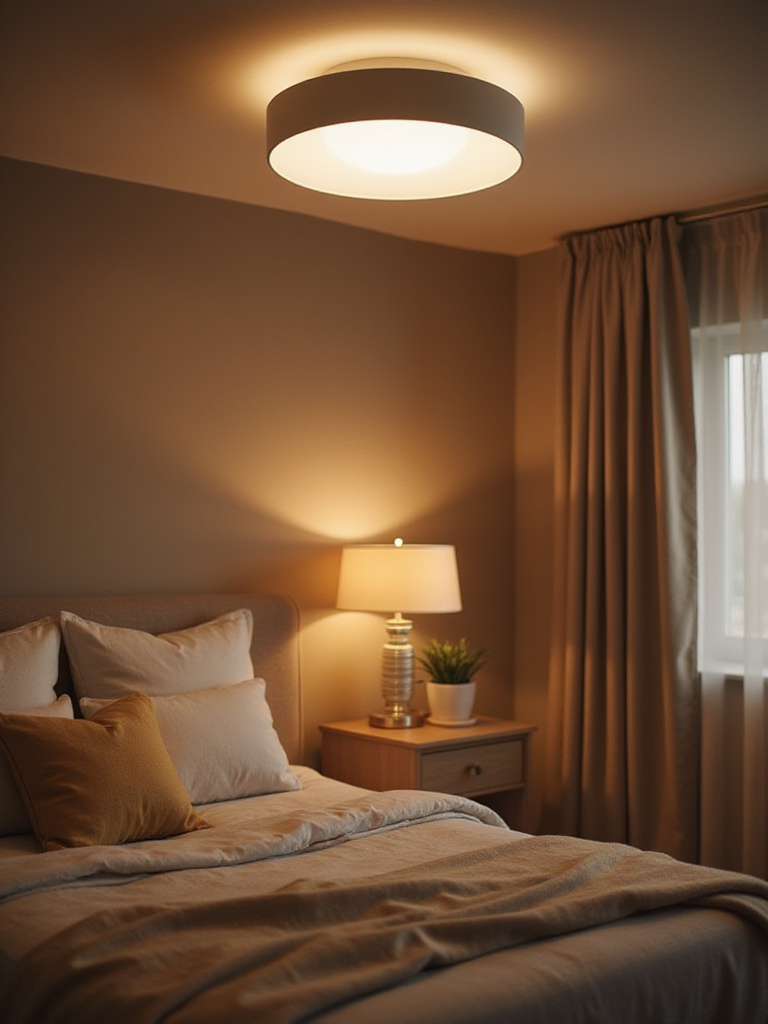
The versatility of modern LED technology extends beyond energy savings to include tunable color temperatures that support healthy circadian rhythms. Smart LED systems can automatically adjust from energizing cool light in the morning to relaxing warm light in the evening, helping regulate your body’s natural sleep-wake cycle. This biological support system enhances sleep quality while reducing reliance on artificial sleep aids.
LED fixtures also generate minimal heat compared to incandescent bulbs, reducing cooling costs in warm climates and creating a more comfortable bedroom environment. The extended lifespan means fewer bulb replacements and reduced maintenance costs over decades of use.
Professional stylists approach LED integration by first assessing your bedroom’s lighting needs, then selecting fixtures that provide both ambient and task lighting while supporting your daily routines and sleep patterns.
9. Maximize Natural Light with Sheer Window Treatments
Sheer curtains and uncovered windows create a direct connection to the outdoors while reducing electricity consumption for daytime lighting by 10-20%. This passive design strategy supports natural circadian rhythms through exposure to full-spectrum daylight, which research shows can improve sleep quality by an average of 46 minutes per night. The psychological benefits of natural light include reduced stress levels and improved mood, essential elements for creating a truly restorative bedroom environment.
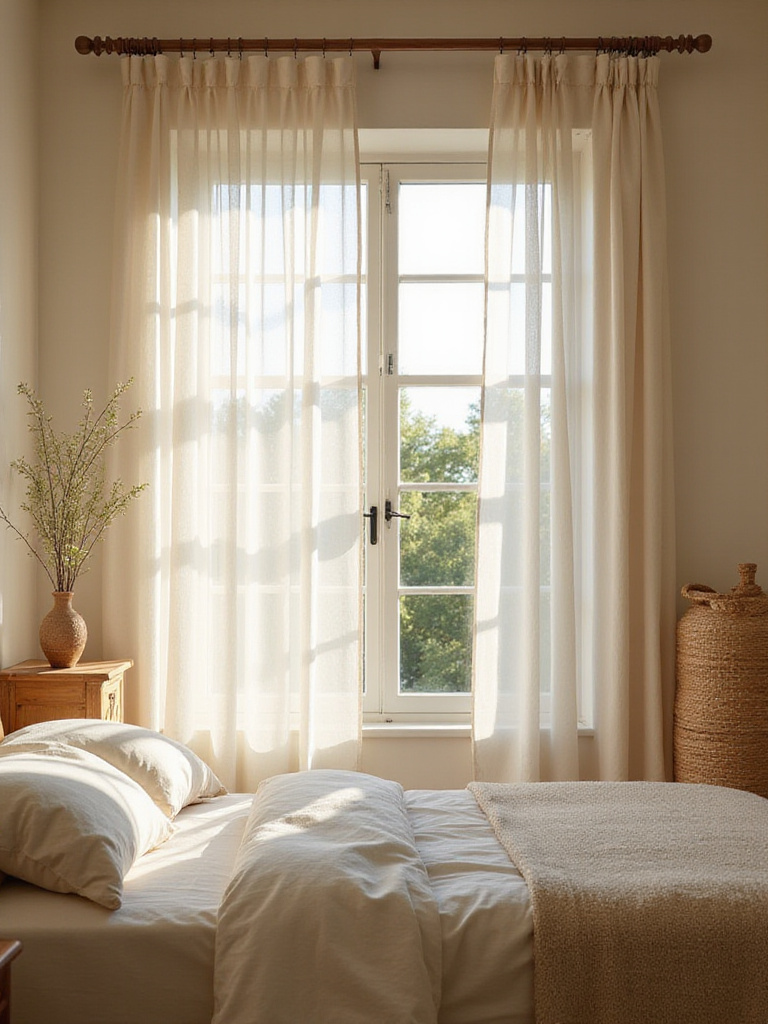
The environmental impact of maximizing natural light extends beyond energy savings to include reduced demand on power grids and decreased carbon emissions from electricity generation. Daylighting strategies can reduce a building’s lighting energy consumption by 20-80%, according to the Department of Energy. This approach also enhances the perception of spaciousness and cleanliness, making your bedroom feel larger and more inviting.
Organic cotton, linen, or hemp sheers provide the perfect balance of light transmission and privacy while maintaining excellent airflow. These natural materials age beautifully and can be composted at the end of their lifecycle, unlike synthetic alternatives that persist in landfills.
The unexpected pairing that always works is combining lightweight sheers for daytime privacy with separate blackout panels for nighttime darkness, creating a flexible lighting system that adapts to your daily needs.
10. Choose Low-VOC Paints for Healthier Indoor Air
Low-VOC and zero-VOC paints eliminate the harmful chemical emissions that conventional paints release into your bedroom air for months or even years after application. These healthier alternatives reduce exposure to formaldehyde, benzene, and other toxic compounds linked to respiratory issues, headaches, and long-term health concerns. The EPA identifies VOCs from paints as major contributors to indoor air pollution, with initial concentrations often reaching 1,000 times higher than outdoor levels immediately after application.
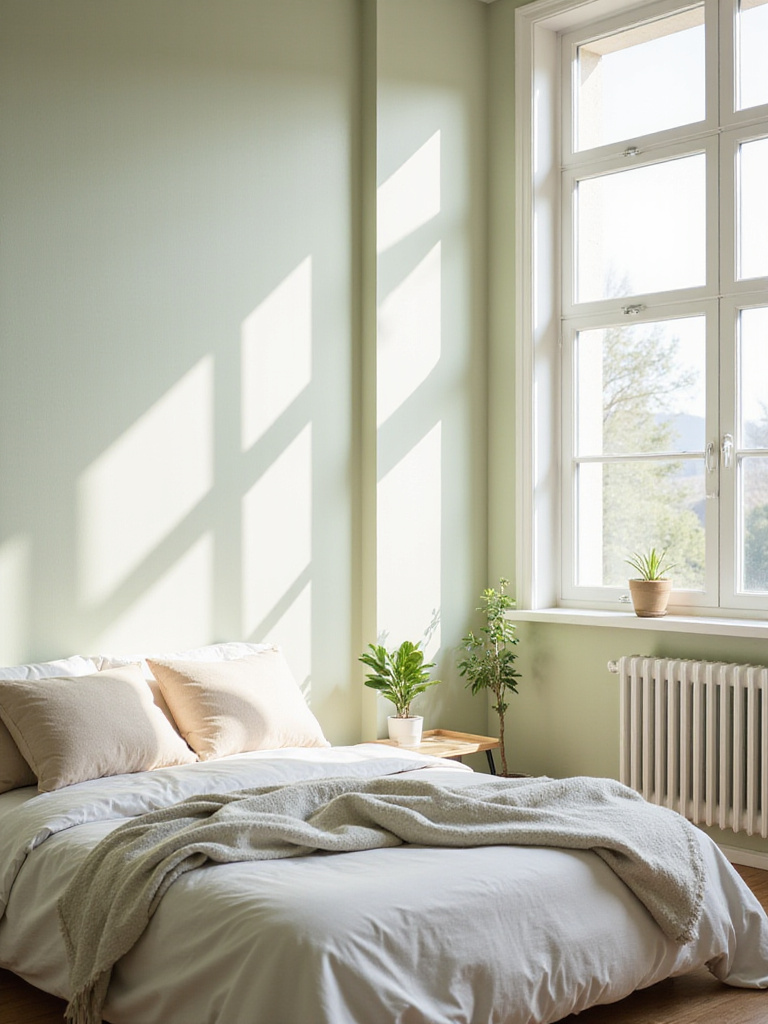
The health benefits of low-VOC paints include improved respiratory function, reduced chemical sensitivity symptoms, and faster room re-occupancy after painting projects. Studies show that individuals with asthma and allergies experience up to 25% fewer symptoms when exposed to low-VOC alternatives compared to conventional paints. The global market for low-VOC paints continues expanding as consumers prioritize health-conscious choices for their homes.
- Certification Standards: Look for GREENGUARD Gold, Zero-VOC, or Cradle to Cradle labels
- VOC Limits: Choose products with less than 50 g/L for low-VOC, under 5 g/L for zero-VOC
- Application Benefits: Reduced odor, faster drying, easier cleanup with water-based formulations
The construction technique that ensures optimal results involves proper surface preparation, adequate ventilation during application, and allowing sufficient curing time before heavy use of the room.
11. Display Botanical Art for Biophilic Connection
Botanical prints and nature-inspired artwork create powerful visual connections to the natural world, satisfying our innate biophilic needs without requiring living plant maintenance. Research in environmental psychology demonstrates that exposure to nature imagery can reduce physiological stress indicators by 8-15% while improving mood and cognitive function. This makes botanical art particularly valuable in bedrooms, where stress reduction and mental tranquility are essential for quality sleep.
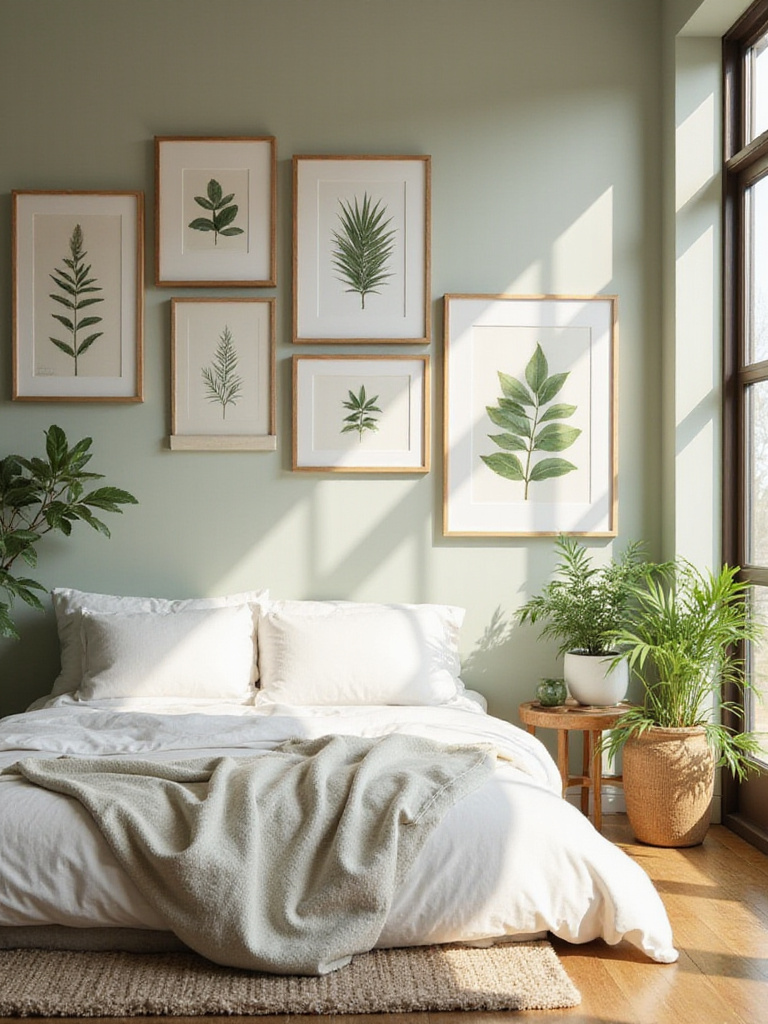
The psychological impact of nature-inspired art extends beyond immediate stress relief to include improved creativity, enhanced focus, and increased feelings of well-being. Interior designers report that 75% of clients express interest in wellness-focused design elements, with botanical artwork being among the most requested features. The visual connection to nature provided by carefully selected prints can substitute for outdoor views when windows face urban environments or neighboring buildings.
Sustainable sourcing becomes crucial when selecting botanical art. Prioritize prints on recycled or FSC-certified paper, frames made from reclaimed wood or bamboo, and support for local artists who use eco-friendly practices. This approach ensures your decorative choices align with your environmental values while supporting responsible artistic practices.
The finishing touch that elevates the entire look involves mixing photographic prints with botanical illustrations and pressed flower art to create textural variety and visual depth that engages multiple senses.
12. Upcycle Furniture with Natural Finishes
Transforming existing furniture with eco-friendly finishes diverts hundreds of pounds of waste from landfills while creating unique pieces that reflect your personal style. This approach reduces furniture acquisition costs by 50-80% compared to purchasing new items while eliminating exposure to the harmful chemicals commonly found in conventional furniture finishes. The EPA reports that furniture generates 12.1 million tons of municipal solid waste annually, with only 0.2% recovered for recycling.
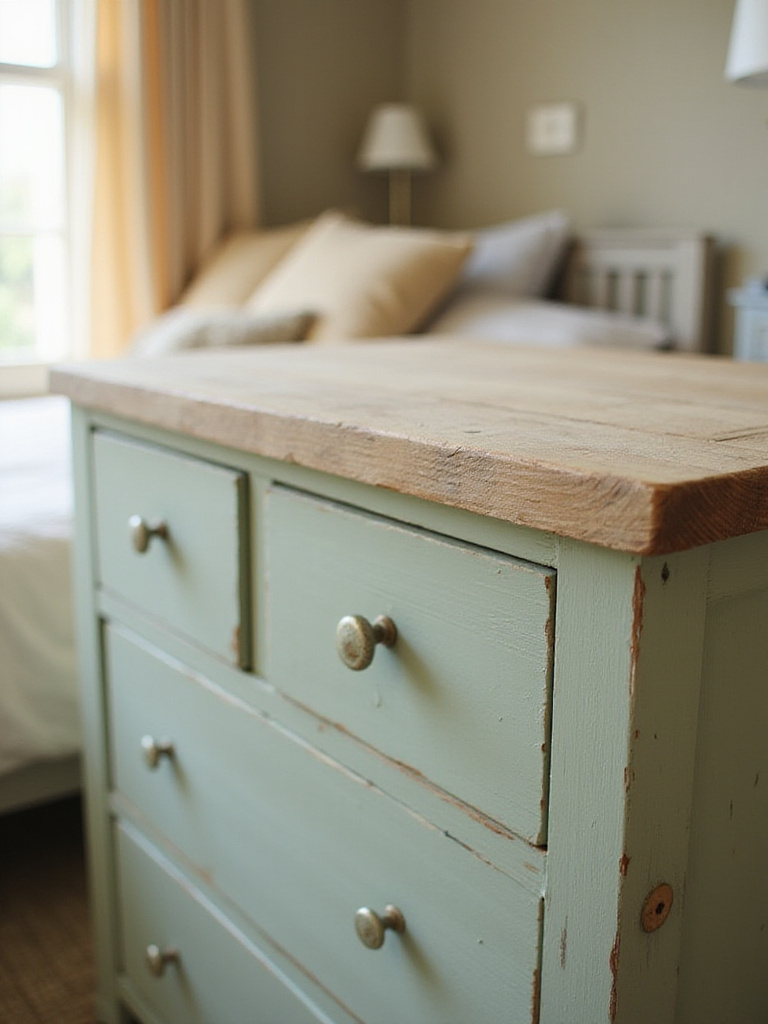
The environmental benefits of upcycling extend beyond waste reduction to include decreased demand for new resource extraction and manufacturing processes. Using natural finishes like tung oil, linseed oil, or beeswax eliminates up to 99% of VOC emissions compared to conventional furniture finishes, creating a healthier indoor environment. These natural alternatives also allow wood to breathe naturally while providing adequate protection against wear and moisture.
The transformation process involves thorough cleaning, light sanding for adhesion, and careful application of your chosen natural finish. Milk paint, chalk paint, and zero-VOC acrylics offer excellent coverage while maintaining environmental responsibility. The unique character that emerges from upcycled pieces cannot be replicated by mass-produced furniture.
What separates artisanal quality from mass-produced alternatives is the attention to detail, use of superior materials, and the individual character that develops through the upcycling process.
13. Create Miniature Plant Displays for Compact Greenery
Small terrariums and miniature plant displays introduce living elements into bedrooms with limited space, providing air purification benefits and biophilic connections without requiring significant floor area. These compact ecosystems can remove up to 20% of airborne VOCs in small, enclosed spaces while creating focal points that enhance visual interest. Research shows that even minimal plant interaction can reduce diastolic blood pressure and subjective stress levels significantly.
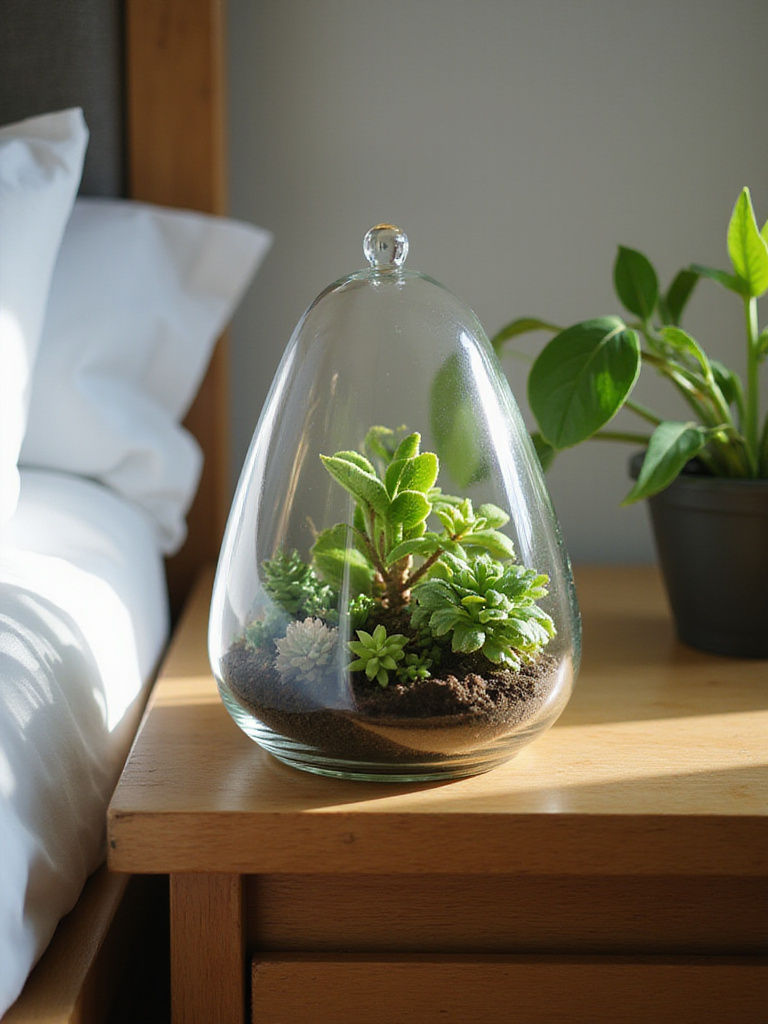
The psychological benefits of miniature plant displays include enhanced mental well-being, reduced cognitive fatigue, and improved mood through connection with living systems. These displays typically occupy less than one square foot of surface area, making them perfect for nightstands, dressers, or floating shelves. The self-contained nature of terrariums creates stable microclimates that require minimal maintenance while providing maximum visual impact.
- Closed Terrarium Plants: Fittonia, small ferns, baby tears (high humidity tolerance)
- Open Display Options: Succulents, air plants, small cacti (low water requirements)
- Maintenance Tips: Light misting for closed systems, weekly watering for open displays
The visual weight balances perfectly when you group terrariums of varying heights and sizes, creating dynamic compositions that draw the eye while maintaining the bedroom’s serene atmosphere.
14. Embrace Minimalist Design for Mental Clarity
Minimalist bedroom design reduces visual clutter and mental stress while significantly decreasing environmental impact through conscious consumption choices. This approach prioritizes quality over quantity, investing in fewer, better-made items that serve multiple functions and last for decades. Research shows that 80% of people report feeling less stressed in decluttered environments, with minimalist spaces promoting better sleep quality and enhanced mental clarity.
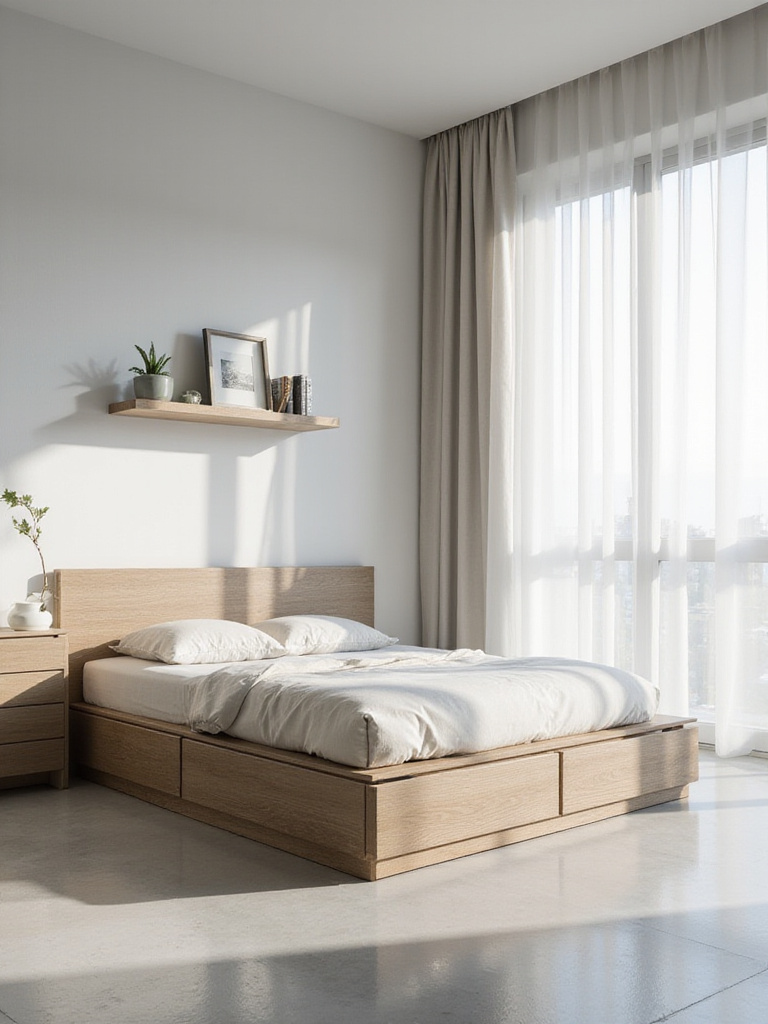
The environmental benefits of minimalism include reduced manufacturing demand, decreased waste generation, and lower carbon footprints from transportation and packaging. The Ellen MacArthur Foundation estimates that 80% of textile waste ends up in landfills globally, making conscious consumption choices particularly important for bedroom furnishings. Minimalist design also improves indoor air quality by reducing surfaces that collect dust and allergens.
Implementation involves systematic decluttering, prioritizing multi-functional furniture, and establishing “one-in, one-out” policies for new acquisitions. Focus on neutral color palettes, natural materials, and ample negative space to create visual calm. The approach emphasizes experiences over possessions, aligning with sustainable lifestyle principles.
The emotional response this evokes begins with a sense of spaciousness and tranquility that supports deeper relaxation and more restorative sleep patterns.
15. Use Essential Oil Diffusers for Natural Aromatherapy
Essential oil diffusers provide natural, chemical-free alternatives to synthetic air fresheners while offering therapeutic benefits that support relaxation and improved sleep quality. Research demonstrates that aromatherapy with lavender or chamomile can reduce cortisol levels by up to 20% while decreasing sleep onset time by 15-20 minutes. The olfactory system’s direct connection to the limbic brain makes scent an immediate pathway to emotional regulation and stress reduction.
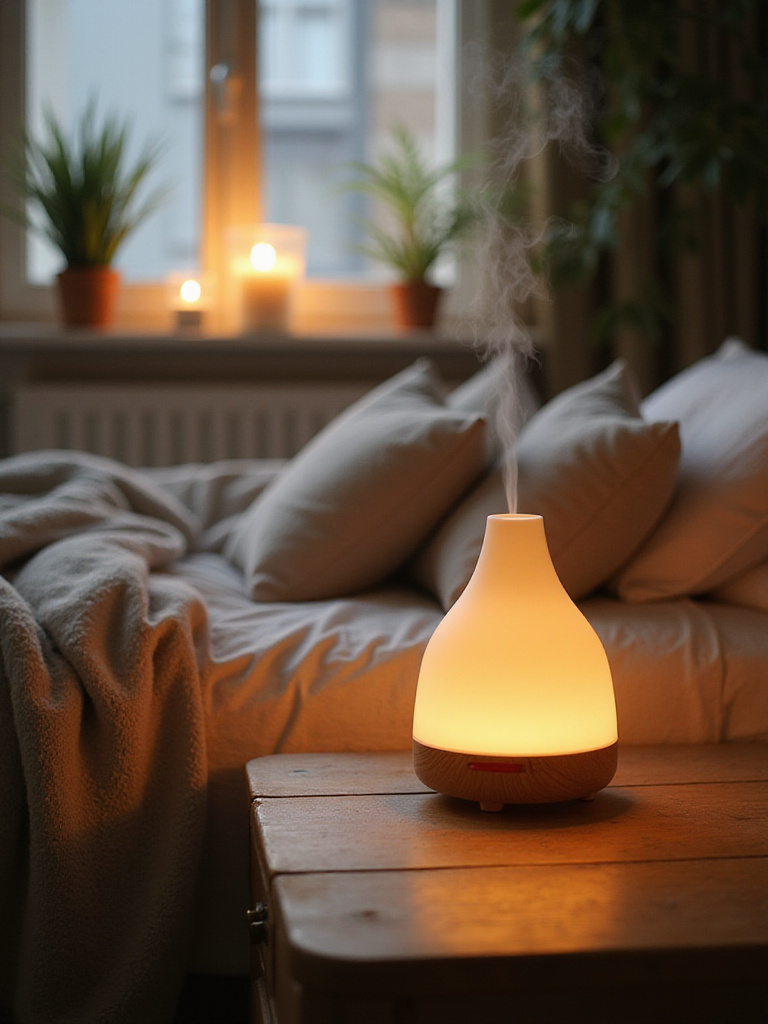
The health advantages of essential oil diffusion include improved respiratory function, enhanced mood, and natural odor elimination without toxic chemical exposure. Ultrasonic diffusers also increase ambient humidity, alleviating dry skin and respiratory irritation common in climate-controlled environments. Studies show that aromatherapy can improve sleep quality scores by up to 35% in individuals with sleep difficulties.
Therapeutic-grade essential oils from organic sources ensure purity and potency while supporting sustainable cultivation practices. Look for USDA Organic certification and third-party testing for quality assurance. Popular bedroom blends include lavender and bergamot for relaxation, or eucalyptus and peppermint for respiratory support.
The artisan’s journey behind handcrafted essential oil blends often involves partnerships with small-scale organic farmers who prioritize environmental stewardship and fair labor practices.
16. Switch to Natural Cleaning Products for Chemical-Free Maintenance
DIY natural cleaning products eliminate exposure to the harmful VOCs and allergens found in conventional cleaners while reducing plastic waste and chemical runoff into water systems. The Environmental Working Group identifies many commercial cleaning products as containing ingredients linked to asthma, allergies, and reproductive issues. Natural alternatives using vinegar, baking soda, and castile soap provide effective cleaning power without compromising indoor air quality.

The health benefits include reduced respiratory irritation, fewer headaches, and decreased allergic reactions, with some individuals experiencing 30-50% improvement in symptoms after switching to natural cleaners. A study in the American Journal of Respiratory and Critical Care Medicine found that using cleaning sprays just once weekly was comparable to smoking 20 cigarettes daily for lung function decline, emphasizing the importance of safer alternatives.
- Basic Ingredients: White vinegar, baking soda, castile soap, hydrogen peroxide, lemon juice
- Cost Savings: 70-85% reduction in cleaning supply expenses annually
- Environmental Impact: Eliminates 10-15 plastic bottles per household yearly
The unexpected environmental benefit comes from reduced chemical runoff that protects waterways and aquatic ecosystems from toxic contamination.
17. Install Smart Thermostats for Optimized Energy Use
Smart thermostats learn your sleep patterns and preferences to optimize heating and cooling efficiency, reducing energy consumption by 10-15% annually through intelligent scheduling and occupancy sensing. These devices prevent energy waste by automatically adjusting temperatures when rooms are unoccupied, with ENERGY STAR certified models saving homeowners approximately $50-145 per year. The technology pays for itself within two years while contributing to reduced greenhouse gas emissions.
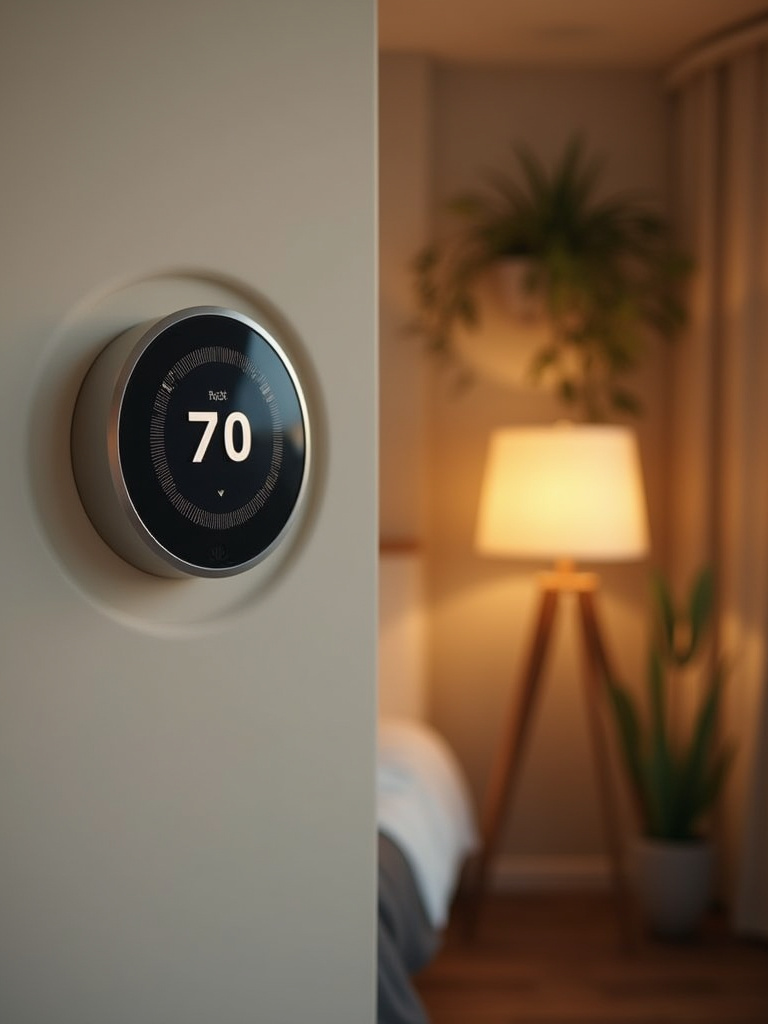
The advanced features of smart thermostats include geofencing that adjusts temperatures based on your location, room sensors that optimize comfort in specific areas, and integration with other smart home devices for comprehensive energy management. These systems provide detailed energy usage reports that help identify additional conservation opportunities throughout your home.
Professional installation ensures optimal performance and compatibility with existing HVAC systems. Many models offer DIY installation options with step-by-step guidance through smartphone apps. The learning algorithms require 2-4 weeks to optimize settings based on your preferences and schedule patterns.
The environmental story behind smart thermostat adoption includes reduced strain on power grids, decreased fossil fuel consumption, and support for renewable energy integration as these devices can respond to grid demand signals.
18. Incorporate Recycled Glass and Upcycled Decor
Recycled glass vases and upcycled decor items transform discarded materials into beautiful, functional pieces that reduce landfill waste while creating unique bedroom accents. This approach diverts 10-20 kg of glass and other materials per household annually from waste streams while requiring 25-30% less energy than producing new glass from raw materials. Every ton of recycled glass prevents 380 pounds of CO2 emissions, making this choice environmentally significant.
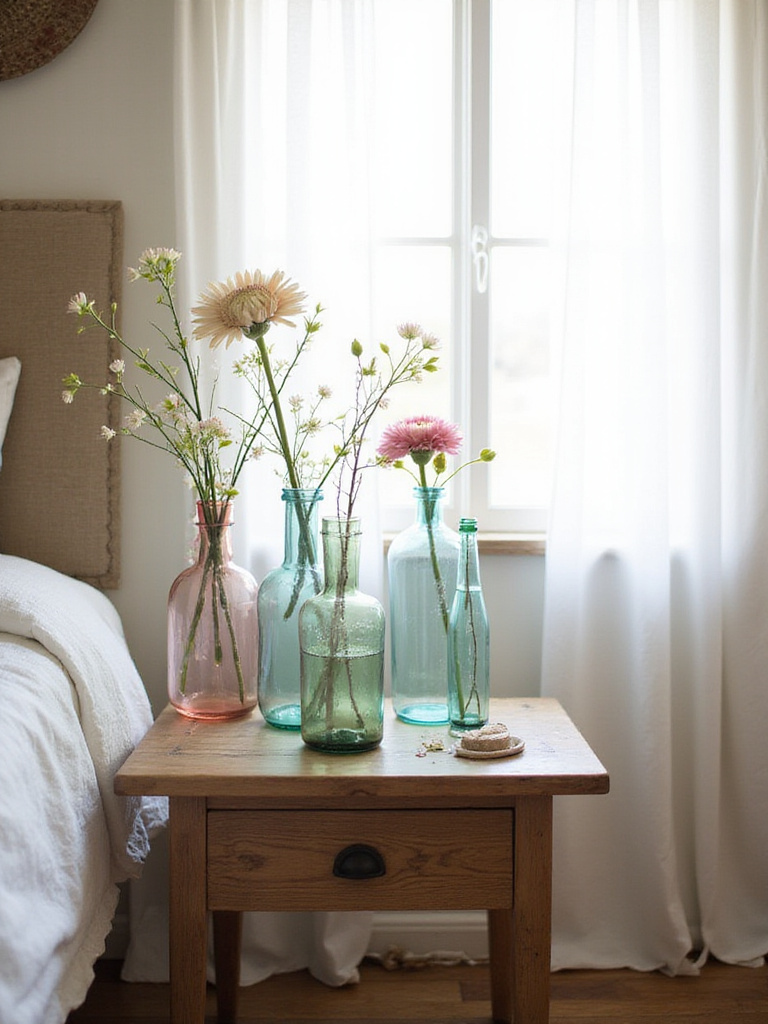
The aesthetic benefits of upcycled decor include unique character and history that mass-produced items cannot replicate. Vintage glass bottles become elegant bud vases, while reclaimed wood creates distinctive shelving or artwork. The imperfections and variations in upcycled pieces add authenticity and visual interest that enhances the organic, lived-in feel essential for comfortable bedrooms.
Sourcing opportunities include thrift stores, flea markets, estate sales, and your own household items destined for disposal. Simple techniques like spray painting, etching, or distressing can transform ordinary objects into custom decor pieces that reflect your personal style while supporting circular economy principles.
The cultural heritage preserved in each upcycled piece includes the stories and craftsmanship of previous eras, connecting your modern bedroom to historical traditions of resourcefulness and creativity.
19. Add Indoor Water Features for Tranquil Soundscapes
Small indoor water features create natural white noise that masks disruptive external sounds while adding humidity and negative ions to your bedroom environment. Research shows that water sounds can improve sleep onset time by up to 20% for light sleepers while reducing perceived stress levels by 15% compared to urban noise exposure. The gentle, consistent sound of flowing water promotes relaxation and mental tranquility essential for quality sleep.
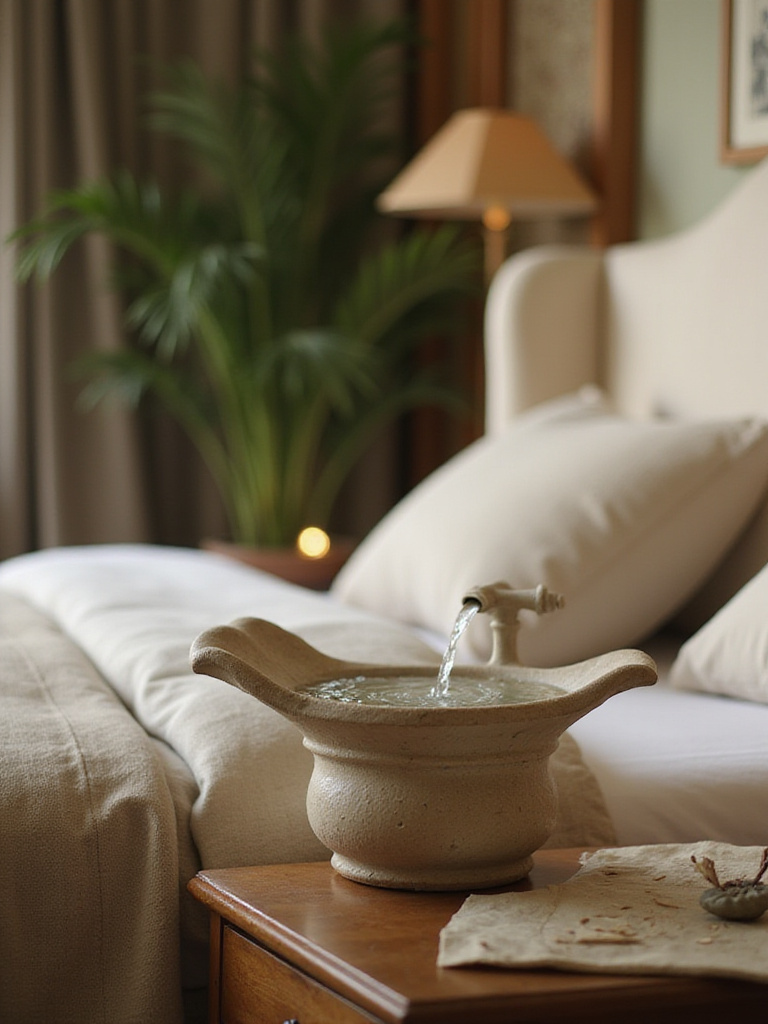
The health benefits extend beyond sound masking to include increased ambient humidity that alleviates dry skin, scratchy throats, and static electricity common in climate-controlled environments. Water features also generate negative ions that can improve mood and cognitive function, similar to the effects experienced near natural waterfalls or ocean waves. The EPA recommends indoor humidity levels between 30-50% for optimal comfort and health.
Maintenance involves using distilled water to prevent mineral buildup, weekly cleaning to prevent algae growth, and ensuring proper water circulation to maintain freshness. Self-contained tabletop fountains offer the easiest maintenance while providing maximum therapeutic benefits.
The mood shifts dramatically when you add the sound of gently flowing water to your bedroom, creating an immediate sense of calm that supports deeper relaxation and more restorative sleep.
20. Design Vertical Plant Walls for Living Art
Vertical plant gardens maximize greenery in minimal floor space while creating dramatic living walls that serve as natural air purifiers and humidity regulators. These installations can reduce indoor CO2 levels by 10-25% and VOCs by 20-30% while adding significant visual impact to bedroom walls. NASA research confirms that living green walls provide superior air purification compared to individual potted plants due to increased surface area and root exposure.
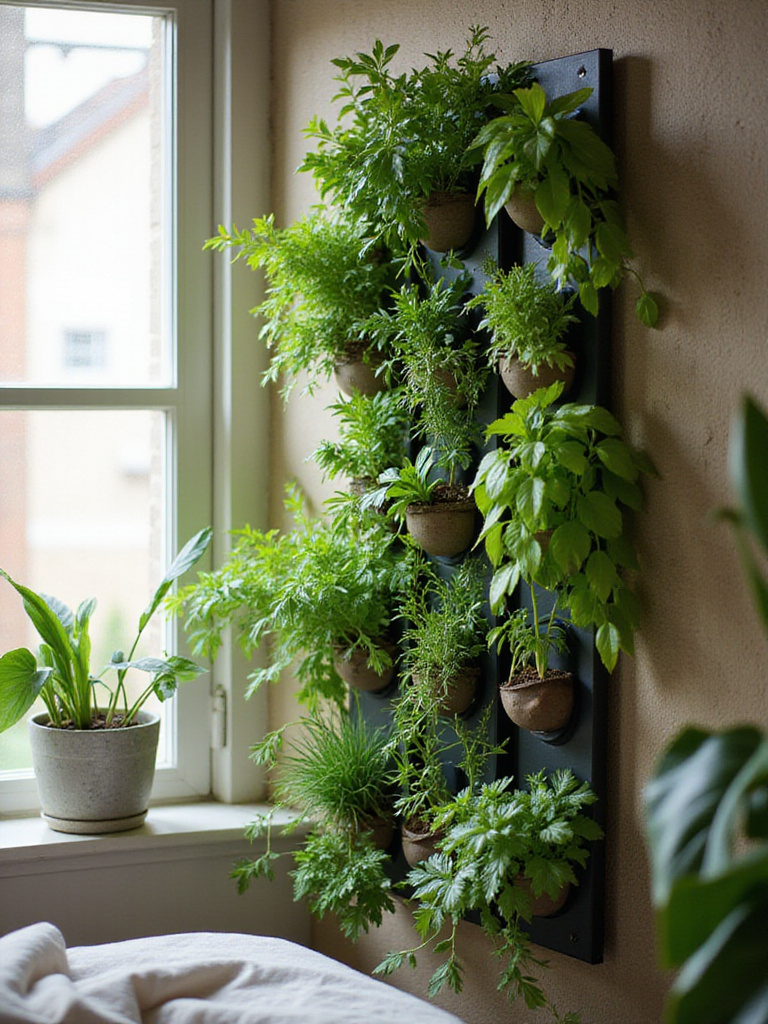
The biophilic benefits include enhanced mental well-being, reduced stress levels, and improved cognitive function through direct connection with living systems. Studies show that exposure to living green walls can reduce perceived stress by 19% while increasing positive mood states by 10%. The vertical format allows for diverse plant combinations that create textural interest and seasonal variation.
- Suitable Plants: Pothos, snake plants, ZZ plants, peace lilies for low-light conditions
- System Options: Modular panels, pocket planters, hydroponic systems for different maintenance levels
- Space Requirements: Minimum 3×4 feet for visual impact, scalable for larger walls
The design language evolved from traditional indoor gardening to incorporate modern irrigation systems, LED grow lights, and automated monitoring that reduces maintenance while maximizing plant health.
21. Cultivate Window Sill Herb Gardens
Window sill herb gardens provide fresh, aromatic plants that naturally freshen bedroom air while offering therapeutic scents and culinary ingredients. Herbs like lavender, mint, and rosemary release pleasant fragrances that can improve sleep quality and reduce stress levels. Research indicates that indoor plants can reduce certain VOCs by 10-25% while providing psychological benefits through nurturing activities and connection with growing systems.
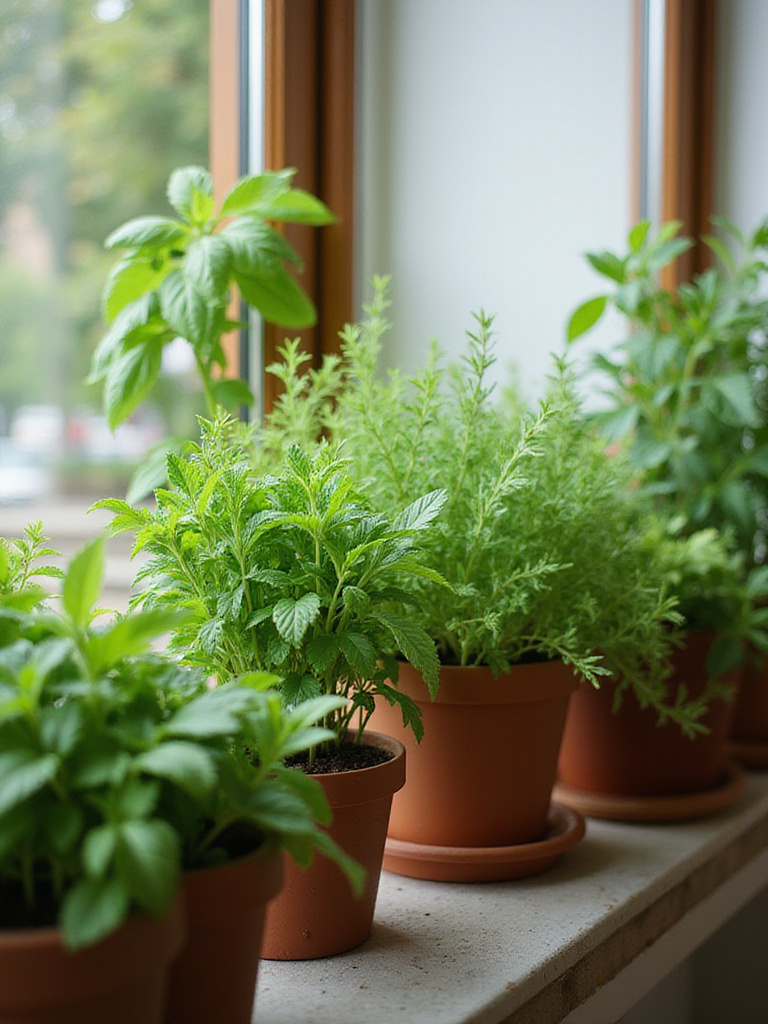
The practical benefits include immediate access to fresh herbs for cooking or tea preparation, reducing grocery expenses and ensuring peak freshness. Herb gardens also provide engaging activities that research shows can decrease stress hormones and improve mood through interaction with living plants. The compact nature of window sill gardens makes them accessible even in small bedrooms with limited space.
Successful cultivation requires selecting herbs suited to your light conditions, using well-draining potting mix, and maintaining consistent watering schedules. South-facing windows provide optimal light for most culinary herbs, while supplemental LED grow lights can support herb growth in lower-light conditions.
The styling mistake most people make is overcrowding plants or choosing varieties that require different care conditions, leading to poor growth and maintenance difficulties.
22. Introduce Raw Wood Accents for Organic Warmth
Unfinished natural wood accents bring organic warmth and texture to bedrooms while eliminating VOC emissions from synthetic finishes. This approach reduces indoor air pollution by 30-50% compared to conventionally finished furniture while creating stronger biophilic connections that research shows can decrease stress levels by up to 15%. Raw wood also offers superior longevity and repairability compared to manufactured alternatives.
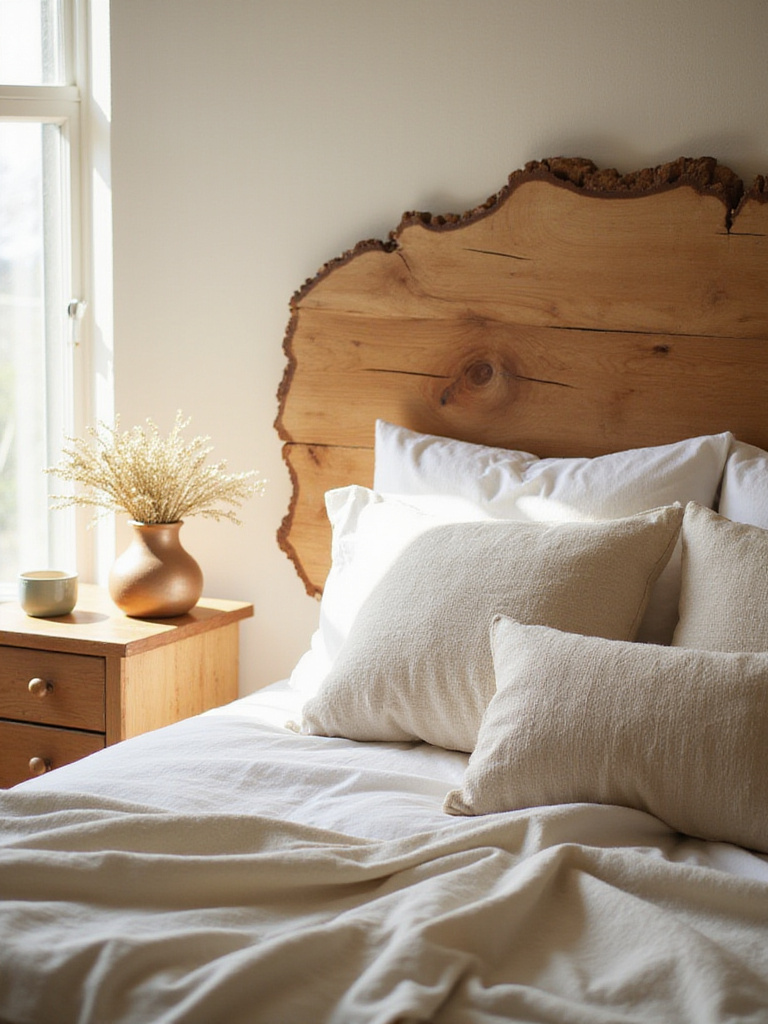
The environmental benefits include reduced processing requirements, lower carbon footprints, and support for sustainable forestry practices when sourcing FSC-certified or reclaimed materials. Natural wood finishes like tung oil, linseed oil, or beeswax provide protection while allowing the wood to breathe naturally and develop character over time. These finishes can be easily renewed or modified as your preferences evolve.
Reclaimed barn wood, live-edge slabs, and salvaged timber offer unique character and history while diverting materials from landfills. Local artisans often specialize in creating custom pieces from reclaimed materials, supporting local economies while reducing transportation emissions.
The traditional methods used result in furniture pieces that develop unique patina and character over decades of use, becoming more beautiful and valuable with age rather than deteriorating like mass-produced alternatives.
23. Replace Plastic Storage with Natural Containers
Woven baskets and glass containers eliminate plastic storage from bedrooms while introducing natural textures and reducing exposure to endocrine-disrupting chemicals like BPA and phthalates. This transition can reduce household plastic waste by 5-10 kg annually while improving air quality through elimination of plastic off-gassing. Natural storage solutions also provide better breathability for stored items, preventing mildew and odors common with plastic containers.
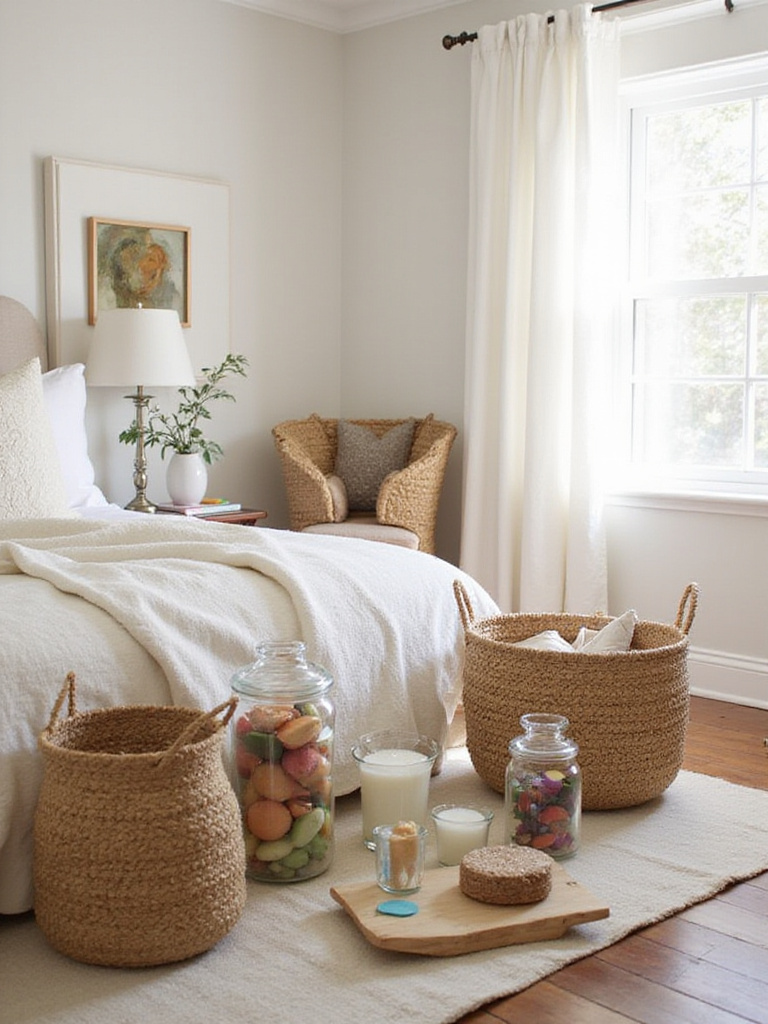
The health benefits include reduced exposure to microplastics and chemical additives that can accumulate in indoor environments over time. Natural fiber baskets made from jute, rattan, or seagrass support sustainable agriculture while providing durable, attractive storage solutions. Glass containers offer complete chemical inertness and infinite recyclability, making them ideal for long-term storage needs.
- Natural Materials: Bamboo, jute, water hyacinth, seagrass for rapid renewability
- Glass Options: Repurposed food jars, borosilicate containers for durability
- Breathability Benefits: Prevents moisture buildup, reduces dust mite populations
The renewable resources used here demonstrate how traditional materials often outperform modern synthetic alternatives in both performance and environmental impact, supporting circular economy principles through biodegradable end-of-life disposal.
Conclusion
Creating an eco-chic green bedroom represents far more than a design trend—it’s a conscious choice that harmonizes personal well-being with environmental stewardship. Each of these 23 green bedroom ideas offers a pathway to transform your most intimate space into a sanctuary that actively supports your health while reducing your ecological footprint. From the calming influence of sage green walls to the air-purifying power of strategically placed plants, these changes demonstrate that luxury and sustainability can beautifully coexist in your personal retreat.
The cumulative impact of implementing these green bedroom ideas extends beyond individual benefits to contribute meaningfully to broader environmental conservation efforts. By choosing organic bedding, FSC-certified furniture, and natural cleaning products, you’re supporting sustainable industries while creating a toxin-free environment that promotes deeper, more restorative sleep. These thoughtful choices prove that small changes in our most personal spaces can generate significant positive impacts for both human health and planetary wellness.
Your journey toward a more sustainable bedroom sanctuary begins with a single conscious choice. Whether you start by adding air-purifying plants, switching to natural fiber rugs, or simply choosing low-VOC paint for your next refresh, each decision moves you closer to the serene, healthy bedroom you deserve. The path to sustainable living starts at home, in the spaces where we rest, recharge, and prepare for each new day.
